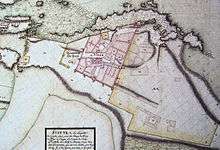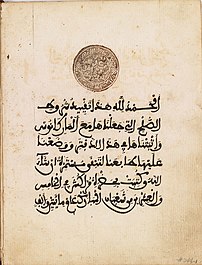Mohammed ben Abdallah
Mohammed Ben Abdellah al-Khatib (c. 1710 – 9 April 1790) (Arabic: محمد الثالث بن عبد الله الخطيب) was Sultan of Morocco from 1757 to 1790 under the Alaouite dynasty. He was the governor of Marrakech around 1750. He was also sultan briefly during 1748. He rebuilt many cities after the earthquake of 1755, including Mogador, Casablanca, and Rabat, and Abdallah Laroui described him as the "the architect of modern Morocco."[1][2] He is notable for having been the leader of one of the first nations to recognize American independence.[3][4]
| Mohammed III of Morocco | |
|---|---|
| Sultan of Morocco | |
| Reign | 1748, 1757 – 1790 |
| Predecessor | Abdallah IV |
| Successor | Yazid |
| Born | c. 1710 Fes, Morocco |
| Died | 9 April 1790 |
| Consort | (first) Lalla Fatima bint Sulaiman of Morocco (second) Lalla Sargetta, an English or Irish lady (third) a daughter of 'Abdu'llah Rahamani (fourth) Lalla Zahra a Howariyya lady from Sais a lady of the Ahlaf tribe another lady of the Ahlaf tribe a lady from Rabat a third lady of the Ahlaf tribe a Beni Husain lady Helen Gloag |
| House | House of Alaoui |
Rule


He was the son of Sultan Abdallah IV who reigned 1745–1757. A more open-minded ruler than many of his forebears, he signed numerous peace treaties with the European powers, and curtailed the power of the Barbary corsairs. He revived the city of Essaouira and invited Jews and the English to trade there. He also built the old medina of Casablanca (Derb Tazi) and renovated the kasbah of Marrakesh. Mohammed III used numerous European technicians and architects for his projects, such as Théodore Cornut and the Englishman Ahmed el Inglizi.
Mohammed ben Abdallah also took steps to remove the foreign presence on Moroccan coasts. He repulsed the French in the 1765 Larache expedition. In 1769 the Portuguese prime Minister Marques Pombal decided to abandon their last outpost in Morocco Mazagan. The Portuguese evacuated the residents of Mazagan to South Brazil and return the outpost to Morocco. Allowing for establishment of diplomatic relations between the two countries for first time. However, the Siege of Melilla (1774) against the Spanish ended in defeat in 1775 when British aid failed to materialize.


In 1777, under the rule of Mohammed ben Abdallah, the Sultanate of Morocco became the first nation to recognize the United States of America as an independent nation.[5]
See also
- Mohammed al-Duayf
- List of Kings of Morocco
- History of Morocco
- Moroccan–American Treaty of Friendship
Notes
- LAROUI, ABDALLAH; Manheim, Ralph (1977). The History of the Maghrib: An Interpretive Essay. Princeton University Press. p. 276. JSTOR j.ctt13x12zg.
- Blondeau, Mathilde; Ouzzani, Kenza Joundy (2016). Casablanca courts-circuits. ISBN 978-9954-37-750-5. OCLC 1135744090.
- "History of the U.S. and Morocco". U.S. Embassy & Consulate in Morocco. Retrieved 2020-04-18.
- News, Morocco World (2012-03-20). "Sidi Mohamed Ben Abdellah's Diplomatic Initiatives towards the United States 1777-1786: Direct Reasons". Morocco World News. Retrieved 2020-04-18.
- Capitalizing on the Morocco-US Free Trade Agreement: A Road Map for Success. Retrieved September 21, 2016.
References
| Preceded by Abdallah IV |
Mohammed ben Abdallah 1757–1790 |
Succeeded by Yazid |
[[Category:1790 deaths]

